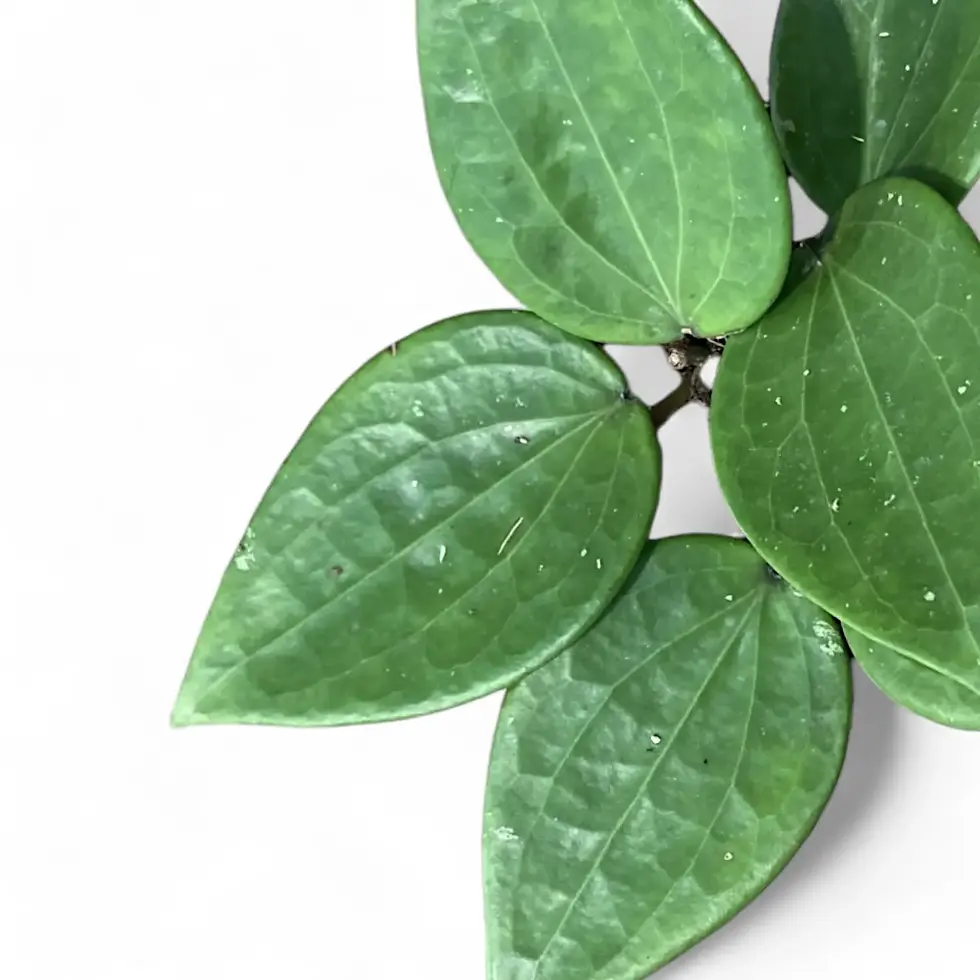Hoya latifolia – Bold Foliage and Tropical Character
Hoya latifolia, often confused with the outdated name Hoya macrophylla, is a vigorous climbing species known for its oversized, paddle-shaped leaves and intensely fragrant flowers. Native to Southeast Asia, this slow-growing epiphyte thrives in bright indoor spaces and rewards patience with clusters of creamy, sweet-scented blooms. Its low-maintenance care and bold look make it a staple for collectors who love dramatic greenery.
What Sets Hoya latifolia Apart?
- Oversized, Glossy Leaves: Thick, dark green blades with raised veins and reddish margins, often reaching 15 cm in length.
- Fragrant Umbels: Produces dense clusters of creamy-white, star-shaped flowers with yellow to orange centers — each cluster up to 30 blooms.
- Slow Climber: Grows as a trailing or climbing vine — perfect for moss poles, trellises, or hanging baskets.
Natural Habitat and Background
- Origin: Indigenous to lowland rainforests of Thailand, Myanmar, and Indonesia.
- Botanical Authority: Hoya latifolia G.Don, published in Gen. Syst. 4: 127 (1838).
- Common Mislabeling: Often incorrectly sold as Hoya macrophylla, a synonym not recognized by current botanical standards.
Indoor Growing Conditions
- Light: Prefers bright, indirect light. An east-facing window is ideal. Avoid harsh midday sun to prevent leaf burn.
- Watering: Water when the top 2 – 4 cm of soil dries out. Use lukewarm, filtered water to avoid mineral buildup.
- Humidity: Thrives at 60 – 80%. Use a humidifier or pebble tray to boost levels in dry rooms.
- Temperature: Best kept between 18 – 26°C. Protect from drafts and temperatures below 15°C.
- Soil Mix: Use a chunky, airy substrate — ideal blends include orchid bark, perlite, and coconut coir.
- Feeding: Apply a diluted, balanced liquid fertilizer every 4 weeks during active growth.
Maintenance, Training, and Propagation
- Repotting: Every 2 – 3 years in spring. Choose terracotta pots with drainage holes for better aeration.
- Support: Guide along a moss pole or trellis for vertical growth; trailing vines can also be trimmed for compactness.
- Pruning: Trim back leggy stems or damaged leaves. Avoid cutting peduncles — they rebloom.
- Propagation: Take stem cuttings with 2+ nodes. Root in water, moist sphagnum, or semi-hydro setups.
- Semi-Hydro Compatible: Adapts well to LECA with consistent humidity and nutrients.
Troubleshooting Tips
- Yellow Leaves: Typically caused by overwatering or poor drainage — adjust watering schedule and substrate.
- Leaf Browning: Often from low humidity or cold exposure. Keep away from radiators and open windows in winter.
- Drooping Leaves: A sign of underwatering or root-bound conditions — check the soil and consider repotting.
- Slow Growth: Normal for this species. Don't over-fertilize — patience is rewarded with better foliage and flowers.
Encouraging Hoya latifolia to Flower
- Give it stability — avoid frequent repotting or moving during the growth period.
- Maintain consistent light, warmth, and humidity.
- Keep it slightly root-bound — this often triggers blooming after 2 – 3 years of maturity.
Frequently Asked Questions
- How big can the leaves get?
Mature leaves can reach up to 15 cm long and 10 cm wide under ideal indoor conditions. - Can Hoya latifolia grow in low light?
It tolerates medium light but thrives best in bright, indirect sun. - Is it pet-safe?
Hoya species are mildly toxic. Ingestion may cause mild irritation or stomach upset — keep out of reach of pets and children.
Bring Bold Tropical Texture to Your Space
Looking for a statement plant with low-effort care? Hoya latifolia G.Don combines dramatic foliage with sweet-scented flowers and a slow, steady growth habit. Order yours today and experience the lush side of low-maintenance indoor gardening!
Hoya latifolia
Hoya latifolia is approximately 15 cm tall and comes in a ⌀ 12 cm pot.
































